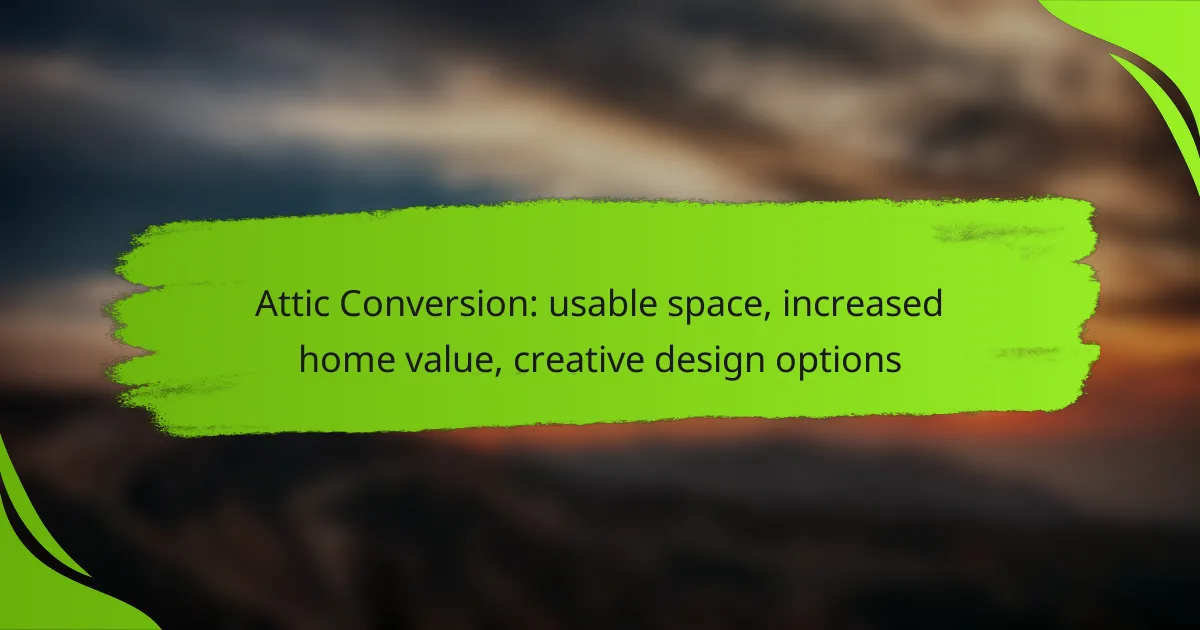An attic conversion is an excellent way to enhance your home’s value while creating additional usable space. By transforming this often-overlooked area, homeowners can explore creative design options that not only improve functionality but also elevate the property’s overall appeal. With careful planning, an attic can become a stylish and practical living area that meets the needs of modern buyers.

How can an attic conversion increase home value in Australia?
An attic conversion can significantly boost home value in Australia by adding usable space and enhancing the overall appeal of the property. Homebuyers often seek additional living areas, making a well-executed attic conversion a valuable investment.
Increased square footage
Converting an attic adds valuable square footage to a home, which can lead to a higher market value. In Australia, properties with more living space typically command better prices, especially in urban areas where space is at a premium.
When planning an attic conversion, consider the local building regulations and ceiling height requirements to ensure the new space meets standards. A well-designed attic can provide an extra bedroom, office, or play area, making the home more functional.
Enhanced property appeal
An attic conversion can significantly enhance a property’s appeal by modernizing its layout and increasing its functionality. Buyers are often attracted to homes with unique features, and a stylishly converted attic can serve as a standout selling point.
Incorporating creative design elements, such as skylights or open-plan layouts, can further elevate the aesthetic appeal. This not only makes the space more inviting but also helps potential buyers envision themselves living there.
Potential for rental income
Converting an attic can create a separate living space that may be rented out, providing a potential source of income. In cities like Sydney or Melbourne, where rental demand is high, this can significantly offset mortgage costs or contribute to overall household income.
When considering this option, ensure that the attic conversion complies with local rental regulations and zoning laws. A well-designed rental space can attract tenants looking for affordable housing in desirable locations.

What are the creative design options for attic conversions?
Creative design options for attic conversions can transform unused space into functional and aesthetically pleasing areas. Key considerations include layout, natural lighting, and storage solutions that maximize the potential of the attic while enhancing the overall value of the home.
Open-plan layouts
Open-plan layouts in attic conversions create a spacious feel and encourage flexibility in how the space is used. By removing unnecessary walls, you can design a multifunctional area that serves as a bedroom, office, or lounge. This approach is particularly effective in smaller attics, where every square meter counts.
When planning an open-plan layout, consider the flow of movement and how different zones will interact. Use furniture placement and area rugs to define spaces without the need for physical barriers. This can help maintain an airy atmosphere while providing distinct functional areas.
Skylights for natural light
Incorporating skylights into your attic conversion can significantly enhance natural light, making the space feel larger and more inviting. Skylights can be strategically placed to maximize sunlight exposure throughout the day, which is especially beneficial in areas with limited window access.
When selecting skylights, consider factors such as energy efficiency and ease of operation. Opt for double-glazed options to improve insulation and reduce heat loss. Additionally, ensure that the installation complies with local building regulations to avoid issues with planning permissions.
Custom storage solutions
Custom storage solutions are essential in attic conversions, where space can be limited and awkwardly shaped. Built-in shelves, under-eave cabinets, and multifunctional furniture can help you make the most of every nook and cranny while keeping the area organized and clutter-free.
Consider using modular storage systems that can be adapted as your needs change. This flexibility allows you to optimize the space over time. Additionally, incorporating open shelving can provide both storage and display options, adding character to the room.

What are the costs associated with attic conversions in Australia?
The costs of attic conversions in Australia can vary widely, typically ranging from tens of thousands to over a hundred thousand Australian dollars, depending on the complexity and scope of the project. Key factors influencing these costs include the size of the attic, the materials used, and any necessary structural changes.
Average renovation costs
On average, homeowners can expect to spend between AUD 30,000 and AUD 100,000 for an attic conversion. This price range often includes design fees, construction costs, and any necessary permits. More extensive renovations, such as adding a bathroom or significant structural reinforcements, can push costs higher.
Labor costs in Australia can account for a significant portion of the budget, often ranging from 40% to 60% of the total expenses. Therefore, obtaining multiple quotes from contractors can help ensure competitive pricing.
Cost-saving tips
To save on attic conversion costs, consider keeping the existing layout simple and minimizing structural changes. Using standard materials rather than custom options can also help reduce expenses. Additionally, planning the project during the off-peak season may lead to lower labor costs.
Another effective strategy is to handle some aspects of the project yourself, such as painting or installing fixtures. However, ensure that any structural work is left to professionals to maintain safety and compliance with local building codes.
Financing options
Homeowners can explore several financing options for attic conversions, including personal loans, home equity loans, and lines of credit. Personal loans often have higher interest rates but can be easier to obtain without equity in the home.
Home equity loans typically offer lower interest rates and can be a good choice for those with sufficient equity. It’s advisable to compare terms and interest rates from various lenders to find the best option for your financial situation.

What are the building regulations for attic conversions in Australia?
Building regulations for attic conversions in Australia vary by state and local council, but generally, they require compliance with specific safety and structural standards. Homeowners should consult their local council to understand the necessary permits and guidelines before starting any conversion project.
Local council requirements
Local councils in Australia have unique requirements for attic conversions, which may include obtaining a development application (DA) or complying with zoning laws. It’s essential to check with your local council to determine if your attic conversion needs approval and what documentation is required.
Some councils may have restrictions on the height of the conversion, the materials used, or the overall design to ensure it fits within the neighborhood’s character. Engaging with your local council early in the planning process can help avoid costly delays and ensure compliance.
Building codes and safety standards
Building codes in Australia mandate that attic conversions meet specific safety standards, including structural integrity, fire safety, and accessibility. The National Construction Code (NCC) outlines these requirements, which apply to all residential buildings undergoing modifications.
Key considerations include ensuring proper ventilation, adequate insulation, and safe egress in case of emergencies. It’s advisable to work with a qualified builder or architect familiar with local codes to ensure your attic conversion adheres to all safety standards and regulations.

What are the prerequisites for a successful attic conversion?
Successful attic conversions require careful planning and consideration of structural integrity, access, and egress. Ensuring these elements are addressed will enhance usability and safety while potentially increasing your home’s value.
Structural integrity assessment
Before converting an attic, it’s essential to assess its structural integrity. This involves examining the existing framework, including beams, joists, and the roof structure, to ensure they can support additional weight and usage.
Engaging a structural engineer can provide a professional evaluation. They may recommend reinforcements or modifications, which can range from simple bracing to more extensive renovations, depending on the current state of the structure.
Access and egress considerations
Access to the attic must be safe and convenient, typically requiring a staircase or a well-placed ladder. A permanent staircase is preferable for usability, while a pull-down ladder may suffice for less frequent use.
Egress is crucial for safety, particularly in case of emergencies. Building codes often require a designated exit, such as a window or door that meets specific size and height regulations, ensuring safe escape routes from the attic space.

How to choose the right contractor for an attic conversion?
Selecting the right contractor for an attic conversion is crucial to ensure the project meets your expectations and complies with local regulations. Focus on experience, references, and clear communication to find a reliable professional who can bring your vision to life.
Evaluating contractor experience
When assessing a contractor’s experience, consider their track record with attic conversions specifically. Look for professionals who have completed several similar projects, as this indicates familiarity with the unique challenges and requirements of converting attic spaces.
Ask potential contractors about their qualifications, including any relevant certifications or licenses. A contractor with a solid background in residential renovations will likely understand local building codes and safety regulations, which is essential for a successful conversion.
Checking references and reviews
Request references from previous clients and take the time to follow up with them. Inquire about their overall satisfaction with the contractor’s work, adherence to timelines, and how well the contractor communicated throughout the project.
Additionally, check online reviews on platforms like Google or Yelp to gauge the contractor’s reputation. Look for patterns in feedback, such as consistent praise for quality or concerns about delays, which can help you make an informed decision.
